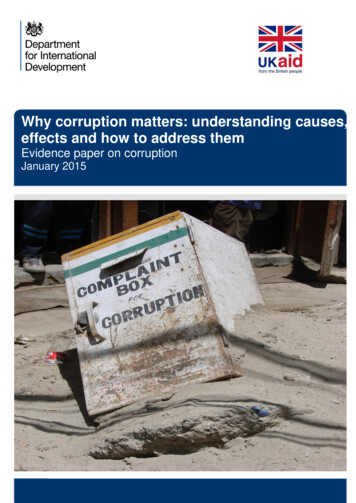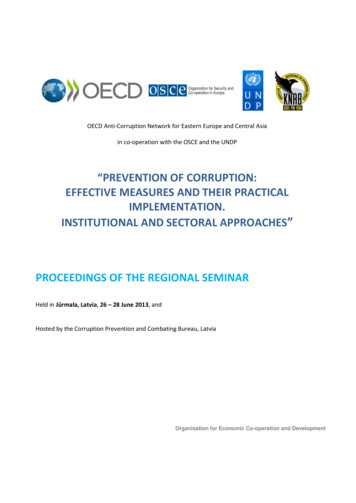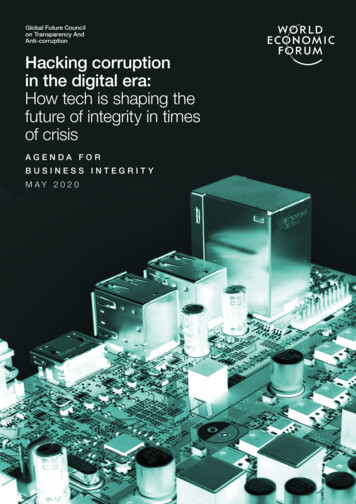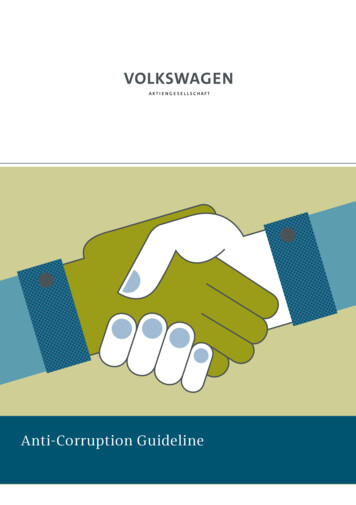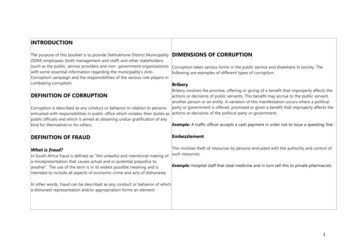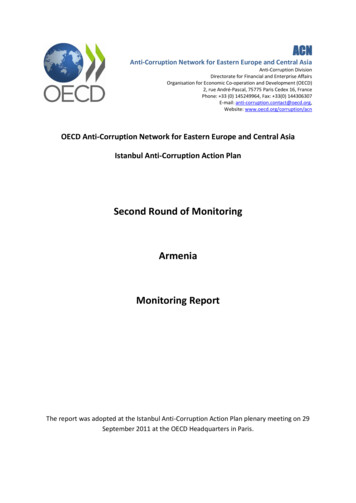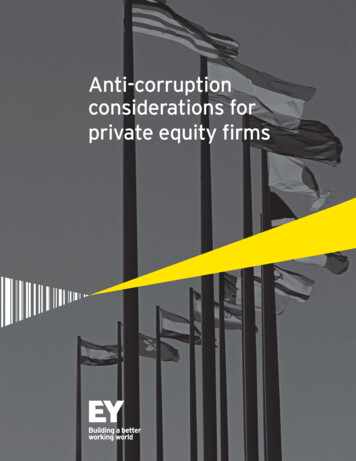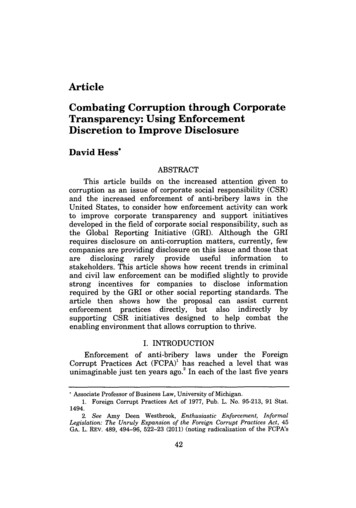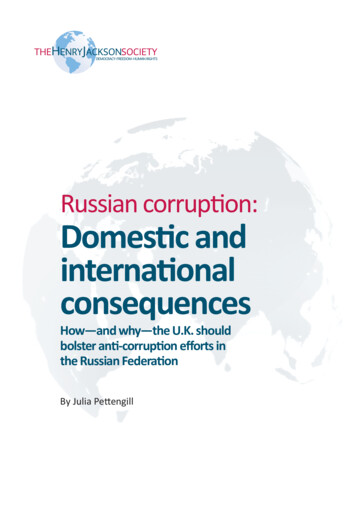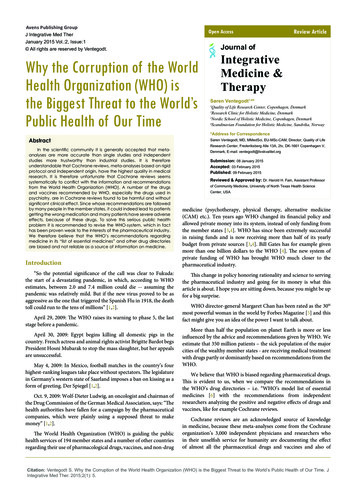
Transcription
Avens Publishing GroupOpen Accesst ing Innova t ionsJInviIntegrativeMed TherJanuary 2015 Vol.:2, Issue:1 All rights are reserved by Ventegodt.Journalof GroupAvensPublishingWhy the Corruption of the WorldHealth Organization (WHO) isthe Biggest Threat to the World’sPublic Health of Our TimeAbstractIn the scientific community it is generally accepted that metaanalyses are more accurate than single studies and independentstudies more trustworthy than industrial studies. It is thereforeunderstandable that Cochrane reviews, meta-analyses based on rigidprotocol and independent origin, have the highest quality in medicalresearch. It is therefore unfortunate that Cochrane reviews seemssystematically to conflict with the information and recommendationsfrom the World Health Organization (WHO). A number of the drugsand vaccines recommended by WHO, especially the drugs used inpsychiatry, are in Cochrane reviews found to be harmful and withoutsignificant clinical effect. Since whose recommendations are followedby many people in the member states, it could indeed lead to patientsgetting the wrong medication and many patients have severe adverseeffects, because of these drugs. To solve this serious public healthproblem it is recommended to revise the WHO-system, which in facthas been proven weak to the interests of the pharmaceutical industry.We therefore believe that the WHO’s recommendations regardingmedicine in its “list of essential medicines” and other drug directoriesare biased and not reliable as a source of information on medicine.Introduction“So the potential significance of the call was clear to Fukuda:the start of a devastating pandemic, in which, according to WHOestimates, between 2.0 and 7.4 million could die -- assuming thepandemic was relatively mild. But if the new virus proved to be asaggressive as the one that triggered the Spanish Flu in 1918, the deathtoll could run to the tens of millions” [1,2].April 29, 2009: The WHO raises its warning to phase 5, the laststage before a pandemic.April 30, 2009: Egypt begins killing all domestic pigs in thecountry. French actress and animal rights activist Brigitte Bardot begsPresident Hosni Mubarak to stop the mass slaughter, but her appealsare unsuccessful.May 4, 2009: In Mexico, football matches in the country’s fourhighest-ranking leagues take place without spectators. The legislaturein Germany’s western state of Saarland imposes a ban on kissing as aform of greeting. Der Spiegel [1,2].Oct. 9, 2009: Wolf-Dieter Ludwig, an oncologist and chairman ofthe Drug Commission of the German Medical Association, says: “Thehealth authorities have fallen for a campaign by the pharmaceuticalcompanies, which were plainly using a supposed threat to makemoney” [1,2].The World Health Organization (WHO) is guiding the publichealth services of 194 member states and a number of other countriesregarding their use of pharmacological drugs, vaccines, and non-drugReview ArticleIntegrativeMedicine &TherapyInvi t ing Innova t ionsSøren Ventegodt1-4*Quality of Life Research Center, Copenhagen, DenmarkResearch Clinic for Holistic Medicine, Denmark3Nordic School of Holistic Medicine, Copenhagen, Denmark4Scandinavian Foundation for Holistic Medicine, Sandvika, Norway12*Address for CorrespondenceSøren Ventegodt, MD, MMedSci, EU-MSc-CAM, Director, Quality of LifeResearch Center, Frederiksberg Alle 13A, 2tv, DK-1661 Copenhagen V,Denmark, E-mail: ventegodt@livskvalitet.orgSubmission: 08 January 2015Accepted: 03 February 2015Published: 09 February 2015Reviewed & Approved by: Dr. Harold H. Fain, Assistant Professorof Community Medicine, University of North Texas Health ScienceCenter, USAmedicine (psychotherapy, physical therapy, alternative medicine(CAM) etc.). Ten years ago WHO changed its financial policy andallowed private money into its system, instead of only funding fromthe member states [3,4]. WHO has since been extremely successfulin raising funds and is now receiving more than half of its yearlybudget from private sources [3,4]. Bill Gates has for example givenmore than one billion dollars to the WHO [4]. The new system ofprivate funding of WHO has brought WHO much closer to thepharmaceutical industry.This change in policy honoring rationality and science to servingthe pharmaceutical industry and going for its money is what thisarticle is about. I hope you are sitting down, because you might be upfor a big surprise.WHO director-general Margaret Chan has been rated as the 30thmost powerful woman in the world by Forbes Magazine [5] and thisfact might give you an idea of the power I want to talk about.More than half the population on planet Earth is more or lessinfluenced by the advice and recommendations given by WHO. Weestimate that 350 million patients – the sick population of the majorcities of the wealthy member states - are receiving medical treatmentwith drugs partly or dominantly based on recommendations from theWHO.We believe that WHO is biased regarding pharmaceutical drugs.This is evident to us, when we compare the recommendations inthe WHO’s drug directories – i.e. “WHO’s model list of essentialmedicines [6] with the recommendations from independentresearchers analyzing the positive and negative effects of drugs andvaccines, like for example Cochrane reviews.Cochrane reviews are an acknowledged source of knowledgein medicine, because these meta-analyses come from the Cochraneorganization’s 3,000 independent physicians and researchers whoin their unselfish service for humanity are documenting the effectof almost all the pharmaceutical drugs and vaccines and also ofCitation: Ventegodt S. Why the Corruption of the World Health Organization (WHO) is the Biggest Threat to the World’s Public Health of Our Time. JIntegrative Med Ther. 2015;2(1): 5.
Citation: Ventegodt S. Why the Corruption of the World Health Organization (WHO) is the Biggest Threat to the World’s Public Health of Our Time. JIntegrative Med Ther. 2015;2(1): 5.ISSN: 2378-1343hundreds or more of different types of non-drug medicine, includinga variety of alternative treatments (CAM) [7].The results from the Cochrane reviews, which most researchersregard as a much more reliable source of information on medicinethan the data coming from the pharmaceutical industry itself, clashharshly with the recommendations of WHO in its drug directories.The Cochrane meta-analyses have systematically found less effect andmore harm from the pharmaceutical drugs than the pharmaceuticalindustry does, when it documents its own products, also when theindustry’s own data is used [8].Many drugs listed in the WHO drug directories, like “WHOsmodel list of essential medicines” [6], have no value as medicineaccording to Cochrane reviews, since the drugs are dangerous, oftenharmful, and without significant beneficial effects for the patient. Youcan even say that the lack of effect and the danger of the drugs are welldocumented!An example of drugs harmfull to patients include cytotoxicchemotherapy, which has a negative effect on the cancer patientquality of life and survival, as found by Ulrich Abel already in 1991[9-11]. Other examples are the lack of improvement of the mentallyill patients’ mental state with anti-psychotic or anti-depressant drugsfound in recent Cochrane reviews [12,13], the newly documentedlack of effect of the influenza vaccines [14], and of the anti-influenzamedicines [15].These independent meta-analyses are of utmost importance andthe results from such studies should be used in both the WHO’s drugdirectories and the national drug directories, rather than the resultsand data from analyses coming directly from the pharmaceuticalindustry [8,16].Leaders of the Cochrane movement have openly criticized thepharmaceutical industry for buying and manipulating the researchersand cheating with the design and results of the randomized controlledtrial (RCT)-test that documents the effects of their drugs [8]. TheDanish director of the Nordic Cochrane Center openly addressedwhat he called “the criminal practices of the pharmaceutical industry”[8] and documented in his book the problem that “Big Pharma”already has taken patient’s lives and caused harm to patients from theuse of poisonous, poorly documented, and ineffective medicine [8].The 2009 Pandemic (Swine Flu)In 1988 Halfdan Mahler (WHO director general during 19731988) in the daily Danish newspaper Politiken warned the worldagainst the power the pharmaceutical industry had over WHO:“the industry is taking over WHO”, he said. But nobody believedhim, because it was too difficult for the public to understand thecomplicated power games he talked about. Unfortunately he wasright.Recent scandals, like the Swine Flu scandal in 2009, has shownthat WHO unfortunately has succumbed totally to the power of thepharmaceutical industry [1,2,17-59]; we have also gained importantinsight in how the WHO-system works. Let us take a look at some ofthe facts that came to public knowledge during this scandal.On June 11, 2009 the WHO declared that the world faced ahorrible and deathly influenza pandemic [17,19,23,27-29,38,41,42,58]J Integrative Med Ther 2(1): 5 (2015)with millions of people predicted to die in the worst disaster inmodern time. All over the world more than two hundred countriesprepared for the pandemic like the plague or the Spanish Flu, whichover the next few months could claim the lives of 40 million people orso - as it happened during the Spanish Flu in the cold and bitter years1918-1919 following World War I.In June and July 2009 national borders were suddenly closed,thousands of public meeting places, like restaurants, cafes, andlibraries in many countries were closed, and millions of travelers werestopped from entering a number of countries in Asia, if they had feveror a common cold [27-29,38,41,42,58].Many people travelling wasted hours on emergency healthcontrols and physicians, hospitals and Ministries of Health panickedand started to send patients home. Many countries started to buyinfluenza vaccines or anti-influenza drugs and spend vast amountsof dollars [1,2,17-59]. The pharmaceutical industry had good daysindeed.As the world reacted to the threat by continuing to buy incredibleamounts of influenza vaccines and anti-influenza medicine a debatestarted in the scientific media like the British Medical Journal (BMJ)[15-25] and slowly also in the public media worldwide [1,2,24-59].Suddenly WHO was accused of “crying wolf” [23] and supporting thepharmaceutical industry [1,2,14-25].It turned out to be a false alarm and the Swine Flu epidemic in2009did not cause the many cases of deaths as first expected [12,13,1525]. Slowly it became known that the WHO actually knew this alreadyBEFORE the director-general Margaret Chan declared the pandemic.This can be seen by the fact that WHO changed the definition of a“pandemic” from meaning “millions of deaths” to mean a nondangerous infection that spreads worldwide only one month beforethe WHO’s declaration of the pandemic [1,2,14-25,28,29].In 2010 a number of representatives from governments all overthe world as well as a number of international organizations i.e. theCouncil of Europe agreed that WHO had caused an internationalpanic and disaster by declaring the mildest flu ever, the A/H1N1“Swine flu” influenza, to be a pandemic threatening mankind. TheCouncil of Europe pointed in a dire report to the problem of WHOgoing private as the true cause of all the trouble [58].During 2010 the situation continued to develop and turnedinto a medical scandal of unknown proportions [1,2,17-59].Ineffective and dangerous medicines worth billions of dollars weresent for destruction. Close and secret links between the WHO andthe pharmaceutical industry producing the vaccines was exposed.The Danish newspaper “Information” found that five researchersinvolving in advising WHO during the scandal had been paid aroundseven million EURO from the vaccine industry [38].The vaccines and the anti-influenza medicine were in Cochranereviews documented to be totally without value and burdening itsusers with a long list of adverse effects [1,2,14-25,28,29,55].Soon it was realized that thousands of patients suffered from a widerange of serious adverse effects: local inflammations, local or systemicmuscle pain, vasculitis, neuritis (autoimmune nerve-inflammations),encephalitis, narcolepsy, and other chronic pains [19,28,29,43Page - 02
Citation: Ventegodt S. Why the Corruption of the World Health Organization (WHO) is the Biggest Threat to the World’s Public Health of Our Time. JIntegrative Med Ther. 2015;2(1): 5.ISSN: 2378-134345,49,51,58]. The media then discovered that the adjuvants used invaccines had many serious adverse effects that were mentioned to thecitizens neither by the companies who sold the vaccines, nor by thegovernments buying and reselling the vaccines [1,2,17-59].It also turned out that the contracts the industry had made withthe countries included a paragraph that the adverse effects were thebuyer’s full responsibility [1,2,17-25,28,29, 30-59].In an interview the Polish health minister revealed everythingabout the horrible industrial contracts, where the pharmaceuticalcompanies - helped by WHO - sold vaccines that were not evenproperly tested! The minister pointed to the fact that the test groupswere extraordinary small – so small that the adverse effects of thevaccines could not even be evaluated [59].In spite of these horrible terms almost every country in Europestill signed the contracts, bought the drugs and vaccines in enormousquantities: two flu-shots per citizen [1,2,17-25,28-59].The media also brought WHO warning thoroughly and repeatedlyand around July 2009 everybody knew about the coming catastrophe.One can easily understand the pressure on the many public healthservices and “better save than sorry” seems to have been the mantraeverywhere. To understand the kind of pressure and stress the statesand the ministries of health were put under, you need to realize thatnot to buy the vaccines could easily, because of the close links betweenthe industry and the press, mean the fall of a whole government.This was what motivated the governments to sign sleepingcontracts with the industry, and WHO played a vital role in this;sleeping means that the contract only become realized if WHO woulddeclare a pandemic – which happened later. This way WHO pushedenormous quantities of vaccines and anti-influenza drugs to its 194member states [1,2,17-59].How involved are WHO in the sales of pharmaceutical drugsin general? Well, for a start, WHO is negotiating the prize of themedicine with the governments on behalf of the pharmaceuticalcompanies [1,2,17-59]. That was another thing that became publiclyknown during the scandal.The scandal came with an after-match: During 2011, 2012, 2013and 2014 many countries’ patient-organizations have started courtcases against the governments, who had given them the ineffectiveand dangerous medicine [28,29,44,51].It also became clear that it was the flu-vaccine-industry that hadtaken control over WHO and created a fake pandemic and the worldwanted an answer to this question: Did WHO fail its responsibility asleader in international health in 2009? [1,2,14-23,28,29,58].WHO agreed after a long period of total denial to make aninvestigation of itself; but after one year the internal WHO-reportfrom the committee concluded that WHO had done nothing wrongat all. After the hearing of about 500 experts the WHO’s investigationgroup concluded that WHO had done absolutely nothing wrong in2009: “WHO performed well in many ways during the pandemic”[60].Everybody who followed the development of the scandal and theexposure in the media - The Guardian, Der Spiegel, the BMJ and aJ Integrative Med Ther 2(1): 5 (2015)number of other serious media - had to conclude that the biggestmedical scandal ever was only possible, because something is wrongin the WHO-system [1,2,17-25,28-59].Facts about InfluenzaWhen the influenza comes it spreads all over via small drops withthe virus in each, but out of all people infected only between 5-15% ofthe population develops the flu; 16% of these cases are influenza typeA, B or C – and only 10% are of type A and B, which we can vaccinateagainst [14].This means that 1% of all gets the A or B influenza. If these peopleare vaccinated with the right type of flu, they can benefit from thevaccine. How many patients are helped of this 1% of the generalpopulation? Unfortunately only a small fraction, as the vaccine forinfluenza virus according to the big Cochrane meta-analysis is highlyineffective [14]. So maybe one in a thousand can be helped to avoid aweek in the bed, or get this year’s flu shortened.Unfortunately vaccinations are not free of adverse effects, as theadjuvant needed to provoke an immune response to a “dead” virionis provoking not only a response to the virus, but also to the body’sown cells and molecules. Which gives a perfectly rational explanationfor the many side effects we see from vaccination, both local andsystem, with local inflammation, local or systemic muscle pain,vasculitis, neuritis, encephalitis or narcolepsy as the severe adverseeffects. The local adverse effects comes with every second vaccine orso, while the dire systemic effects are seen in one patient out of 1,000.If you vaccinate 1,000,000 people you will safe 1,000 from influenza,but you give 1,000 side effects, sometimes worse than the influenzaitself. Such a negative balance between positive and negative effectswill in a rational regime lead to the conclusion that the vaccine is nota rational medicine. It has no general use [14].If the influenza is very mild – as the Swine Flu A/H1N1 we had inthe 2009 pandemic – there is no reason to fear it at all and even lessreason to try to vaccine for it. Actually the pandemic H1A1 flu wasthe mildest flu we ever had – pandemic or epidemic and it was evenpredictable from the statistics on the H1A1 flu that pandemics aregetting milder and milder; all experts who were independent of thevaccine industry predicted that this pandemic would to be the mildestinfluenza pandemic ever [1,2,17-59].So now compare this to the fact that WHO warned the worldthat many million people would die from it. Remember that WHOdeclared that we faced a deathly, horrible influenza pandemic,comparable to the Spanish flu in 1918-19, which killed about 40million people.And consider the impact of this. In many countries the panic wastotal. In Egypt the government ordered all pigs slaughtered [56]; inMexico the government closes all restaurants and public places [56].In Asia the borders into China, Japan, Nepal and a number of othercountries were closed for everybody with a fewer. A hundred milliontravelers had their travel prolonged with security checks for hours.Thousands of passengers with common colds were sent back home.How Was the Vaccines Sold?The WHO declaration of pandemic had an interestingPage - 03
Citation: Ventegodt S. Why the Corruption of the World Health Organization (WHO) is the Biggest Threat to the World’s Public Health of Our Time. JIntegrative Med Ther. 2015;2(1): 5.ISSN: 2378-1343consequence for a large number of pharmaceutical companies sellingthe vaccine and other types of flu medicine.The deeper the investigative journalist and people fromindependent organizations like the European Parliament digged,the uglier became the truth that was revealed. In the end an intimatecooperation between the pharmaceutical industry and WHO wasexposed; a large number of people from the industry had been placedin secret advisory groups in WHO close to the Chinese directorMargaret Chan [1,2,17,18,26-32,34,36,38,41,43,44,54-56,59]. Thesepeople got in this way direct access to the control over the total WHOsystem.So the world learned that the pharmaceutical industry wasrunning WHO! Wow So the industry itself declared the pandemicthat forced all European countries and many more to buy enormousamount of ineffective and dangerous medicines [1,2,17-25,28,29,3159]. But the scandal did not stop there. The contracts also containedparagraphs that transferred all responsibility for the adverse effectsof the vaccine over to the governments of the countries [1,2,17-59].When the Council of Europe learned about this it caused extremeanger; WHO was subsequently criticized [60]. In the end it turnedout that the Cochrane experts and the Polish minister of health hadbeen correct in their critique all the time, when they said that thepharmaceutical industry and WHO together were selling vaccinesand medicines that were not properly tested and dangerous [61-64].In spite of an international scandal directly caused by WHO thatmade hundreds of countries pay billions of dollars and EUROs fromunnecessary vaccinations and medications, and in spite of thousandsof victims for the serious adverse effects of these treatments, WHOconcluded after the Swine Flu Scandal that all went well and happenedaccording to the plans from 2005 [64] and that no errors had beenmade in the WHO system [65].ConclusionsToday after the Swine Flu Scandal it seems that the pharmaceuticalindustry has gained control over the WHO system, leading to anextreme bias towards the use of not only ineffective and unnecessaryinfluenza vaccines and medicines, but also to the use of antipsychotics,antidepressant, antianxiety and other psychopharmacological drugs,cytotoxic anti-cancer chemotherapy, and a number of other drugs,which according to independent meta analyses and Cochrane reviewsare found to be without significant beneficial effect – and oftenharmful.We recommend a fundamental revision of the WHO-system thathas proven itself weak to the interests of the pharmaceutical industry.References1. Bethge P, Elger K, Glüsing J, Grill M, Hachenbroch V, et al. (2010)Reconstruction of a mass hysteria: The Swine flu panic of 2009. Der SpiegelPart 1.2. Bethge P, Elger K, Glüsing J, Grill M, Hachenbroch V, et al. (2010)Reconstruction of a mass hysteria: The Swine flu panic of 2009. Der SpiegelPart 2.3. WHO (2011) Program budget 2012-2013.4. WHO (2012) Top 20 voluntary contributors to WHO 2012-2013.5. http://www.forbes.com/profile/margaret-chan/J Integrative Med Ther 2(1): 5 (2015)6. WHO (2013) WHO Model list of essential medicines.7. (2005) Committee on the use of complementary and alternative medicineby the american public, Complementary and alternative medicine (CAM)in the united states. Institute of medicine (US), Washington, DC: NationalAcademies Press.8. Gøtzsche P (2013) Deadly medicines and organised crime: How big pharmahas corrupted healthcare”, New York: Radcliffe.9. Abel U (1992) Chemotherapy of advanced epithelial cancer—a critical review.Biomed Pharmacother 46: 439-52.10. Abel U (1990) Chemotherapy of advanced epithelial cancer. Stuttgart:Hippokrates Verlag, German.11. Abel U (1995) Chemotherapie fortgesch-rittener Karzi-nome. EinekritischeBestandsaufnahme. Berlin: Hippo-krates, German.12. Adams CE, Awad G, Rathbone J, Thornley B (2007) Chlorpromazine versusplacebo for schizophrenia. Cochrane Database Syst Rev CD000284.13. Moncrieff J, Wessely S, Hardy R (2004) Active placebos versusantidepressants for depression. Cochrane Database Syst Rev CD003012.14. Jefferson T, Di Pietrantonj C, Rivetti A, Bawazeer GA, Al-Ansary LA, etal. (2014) Vaccines for preventing influenza in healthy adults. CochraneDatabase Syst Rev CD001269.15. Jefferson T, Jones MA, Doshi P, Del Mar CB, Hama R, et al. (2014)Neuraminidase inhibitors for preventing and treating influenza in healthyadults and children. Cochrane Database Syst Rev CD008965.16. Ventegodt S, Merrick J (2010) A review of the Danish National Drug Directory:Who provides the data for the register? Int J Adolesc Med Health 22: 197212.17. Braillon A (2014) The World Health Organization: No game of thrones. BMJ.18. Cohen D, Carter P (2010) Conflicts of interest- WHO and the pandemic flu“conspiracies”. BMJ 340: c2912.19. Cohen D, Carter P (2009) WHO and the pandemic flu “conspiracies”. BMJ.20. Doshi P, Jefferson T (2010) WHO and pandemic flu. Another question forGSK. BMJ 340: c3455.21. JeffersonT, Doshi P (2014) Multisystem failure: the story of anti-influenzadrugs. Recenti Prog Med 105: 187-190.22. Jefferson T, Doshi P (2010) WHO and pandemic flu. Time for change, WHO.BMJ 340: c3461.23. Law R (2010) WHO and pandemic flu. There was also no new subtype. BMJ340: c3460.24. Payne D (2012) Tamiflu: the battle for secret drug data. BMJ 345: e7303.25. Watson R (2010) WHO is accused of “crying wolf” over swine flu pandemic.BMJ 340: c1904.26. Zarocostas J (2010) Swine flu pandemic review panel seeks access toconfidential documents between WHO and drug companies. BMJ 340:c2792.27. Aagaard HL (2009) Vaccine. for & imod. Berlingske.28. (2010) World Health Organization scientists linked to swine flu vaccinemakers. Abc News.29. (2013) Way opened for Pandemrix swine flu jab compensation. BBC.30. Holder R, Loertscher S, Rohner D (2010) Biased experts, costly lies, andbinary decisions. SSRN.31. (2010) WHO swine flu experts ‘linked’ with drug companies. BBC.32. Cohen D, Carter P (2010)Organization on planning forfor pharmaceutical firms thatpreparing. These conflicts ofKey scientists advising the World Healthan influenza pandemic had done paid workstood to gain from the guidance they wereinterest have never been publicly disclosedPage - 04
Citation: Ventegodt S. Why the Corruption of the World Health Organization (WHO) is the Biggest Threat to the World’s Public Health of Our Time. JIntegrative Med Ther. 2015;2(1): 5.ISSN: 2378-1343by WHO, and WHO has dismissed inquiries into its handling of the A/H1N1pandemic as “conspiracy theories.” BMJ 340: c2912.50. Stein R (2010) Reports accuse WHO of exaggerating H1N1 threat, possibleties to drug makers.33. (2011) Australian journalist wins prestigious award for exposing flu vaccinescandal. The refusers.51. Stenver D (2014) Bivirkninger ved influenzavaccination. Sundhedsstyrelsen,dk.34. Edwards T (2010) Big pharma probed for ‘false’ swine flu pandemic.52. (2014) Influenza. Sundhedsstyrelsen, dk.35. Ejbye AE, Korsgaard P (2013) Kun en ud af 100 har gavn af influenzavaccine.Ekstra Bladet.53. Tanjug RS (2012) BELGRADE –The Appellate Court has confirmed theSpecial Court’s decision to declare itself incompetent to try suspects in theswine flue vaccines case. B92.net.36. Fletcher (2014) Swine flu scandal: Billions of pounds are wasted on vaccines.Express.37. Fletcher V (2010) Swine flu scandal: Billions of pounds are wasted onvaccines. Express.54. Villesen K, Voller L (2009) Secrete committee gives advices to WHO onSwine Flu Hemmeligkomitérådgiver WHO on svine influenza. Information.38. Galushko I (2009) The reality behind the swine flu conspiracy. RT.55. Voller L, Villesen K (2009) WHO-advisers hides million-euro contributionsfrom the pharmaceutical industry WHO-rådgiver skjuler millionbidrag framedicinalindustrien. Information.39. (2009) Can we trust WHO? [Tør vi stole på WHO?]. Information.56. Walsh F (2010) WHO swine flu experts ‘linked’ with drug companies. BBC.40. Mercola J (2009) Major victory with swine flu scandal. Infowars.57. Watson S (2009) Baxter to develop swine flu vaccine despite bird flu scandal.Infowars.41. Neale T (2010) World Health Organization scientists linked to swine fluvaccine makers. ABC news.58. (2010) 2009 flu pandemic by country. Wikipedia.42. Petersen MH (2013) Influenzavaccine koblet til narkolepsi. MedWatch.59. William FE (2009) Mega corruption at the WHO. Rense.com.43. Rappoport J (2013) A new giant vaccine scandal exposes government liesand psyops. Jon Rappoport’s Blog.60. Flynn P (2010) The handling of the H1N1 pandemic: more transparencyneeded. Council of Europe.44. Ramesh R (2010) Report condemns swine flu experts’ ties to big pharma.The Guardian.61. (2015) Polish health ministry Mrs. EwaKopacz gives speech in PolishParliament. Youtube.45. Sample I (2013) Swine flu vaccine can trigger narcolepsy, UK governmentconcedes. The Guardian.62. Gøtzsche PC (2014) Psychiatry has gone astray. Politiken.47. Sørensen A (2009) Vaccine forbindes med alvorlige bivirkninger. Berlingske.63. Interview with epidemiologist Tom Jefferson’ (2009) A Whole industry iswaiting for a pandemic’ the world has been gripped with fears of swine flu inrecent weeks. In an interview with SPIEGEL, epidemiologist Tom Jeffersonspeaks about dangerous fear-mongering, misguided, money-driven researchand why we should all be washing our hands a lot more often. Der Spiegel.48. Sørensen AB, Cuculiza M (2014) Influenzavaccine: Sundhedsstyrelsenfortier alvorlige bivirkninger. MX.64. WHO (2005) Strengthening global health security by implementing theInternational Health Regulations.49. Sørensen AB, Cuculiza M (2014) Influenza-vaccination beskytter digsjældent, MX.65. WHO (2011) Report of the strengthening response to pandemics and otherpublic‑health emergencies.46. Shanahan C (2014) Law firm not expecting swine flu narcolepsy case in courtbefore 2016. Irish examiner.AcknowledgementsCopyright: 2015 Ventegodt S. This is an open access articledistributed under the Creative Commons Attribution License, whichpermits unrestricted use, distribution, and reproduction in any medium,provided the original work is properly cited.J Integrative Med Ther 2(1): 5 (2015)The Danish Quality of Life Survey, Quality of Life Research Centerand The Research Clinic for Holistic Medicine, Copenhagen, wasfrom 1987 till today supported by grants from the 1991 PharmacyFoundation, the Goodwill-fonden, the JL-Foundation, E. Danielsenand Wife’s Foundation, Emmerick Meyer’s Trust, the FrimodtHeineken Foundation, the Hede Nielsen Family Foundation, PetrusAndersens Fond, Wholesaler C.P. Frederiksens Study Trust, Else& Mogens Wedell-Wedellsborg’s Foundation and IMK AlmeneFond. The research in quality of life and scientific complementaryand holistic medicine was approved by the Copenhagen ScientificEthical Committee under the numbers (KF)V. 100.1762-90, (KF)V. 100.2123/91, (KF)V. 01-
Ventegodt S. Why the Corruption of the World Health Organization (WHO) is the Biggest Threat to the World's Public Health of Our Time. J Integrative Med Ther. 2015;2(1): 5. J Integrative Med Ther 2(1): 5 (2015) Page - 02. ISSN: 2378-1343. hundreds or more of. different types of non-drug medicine, including a variety of alternative treatments .


